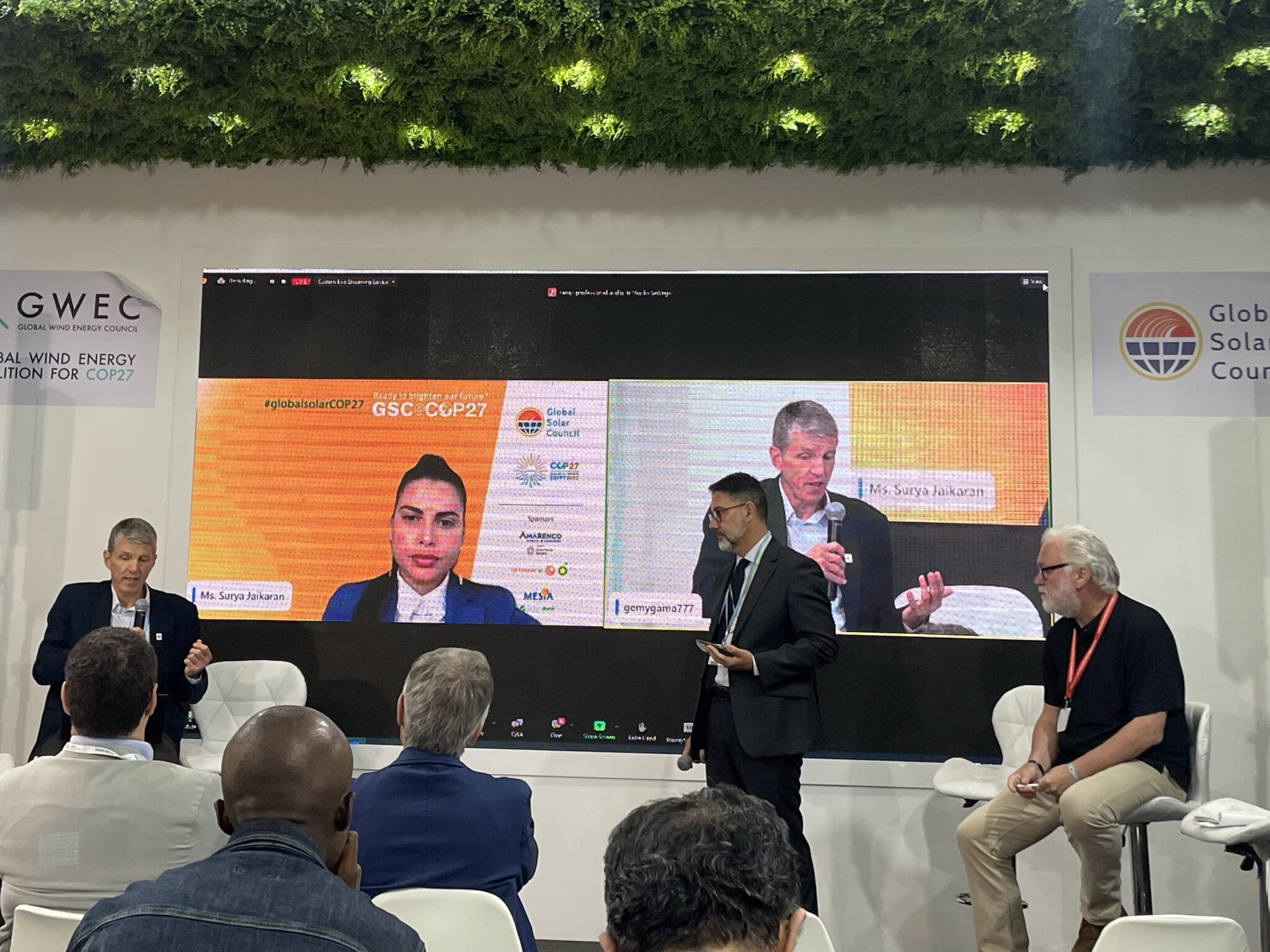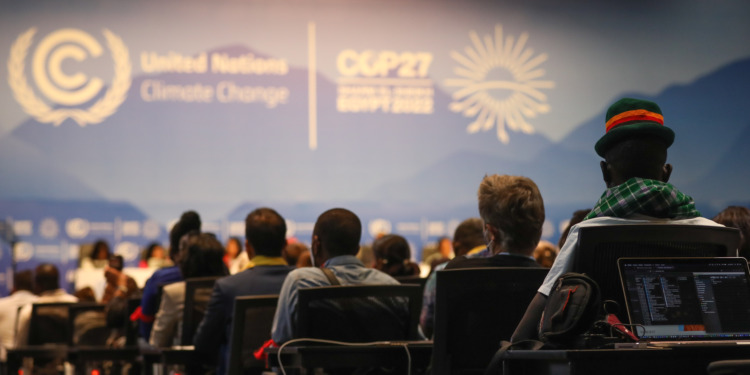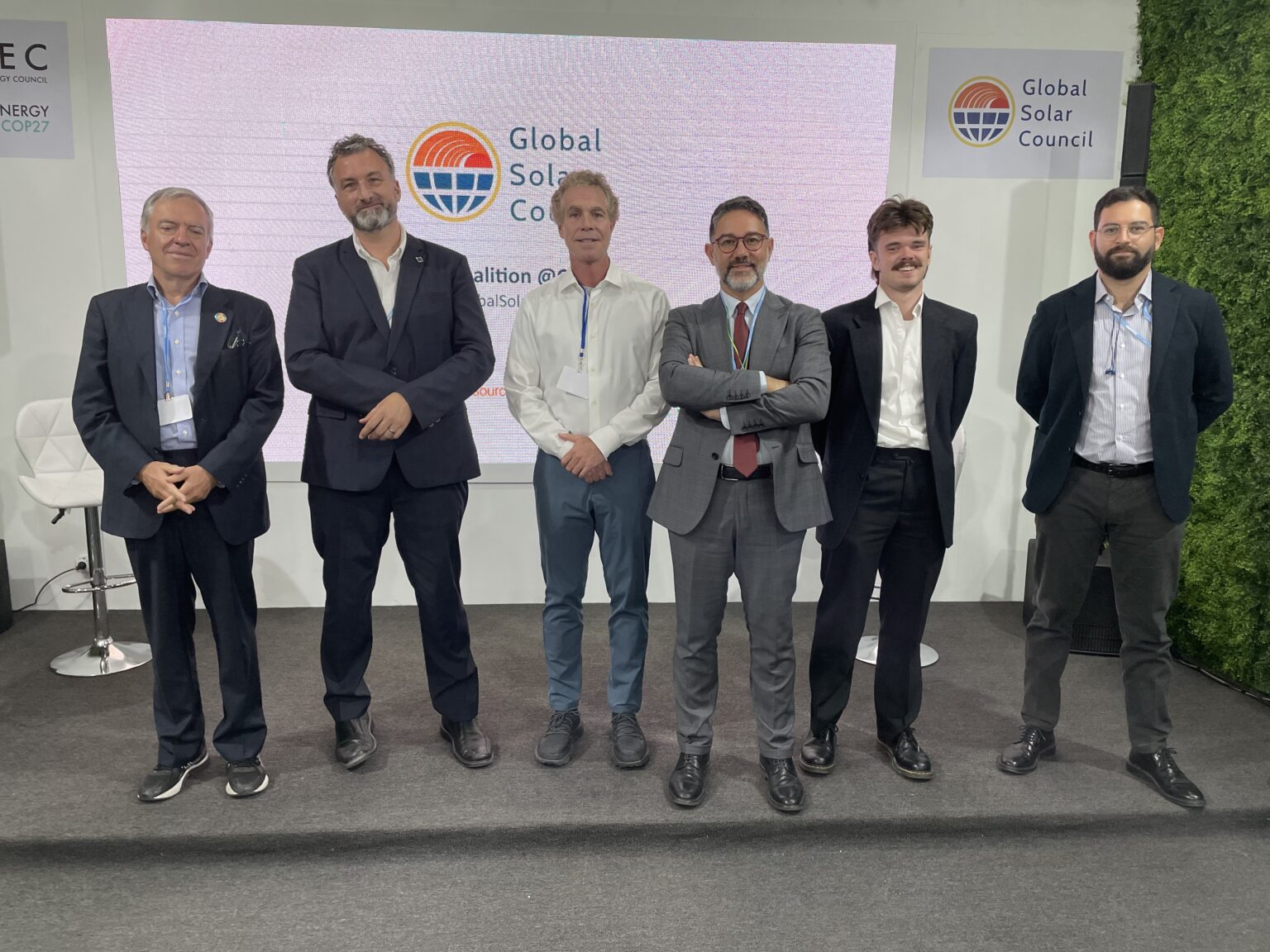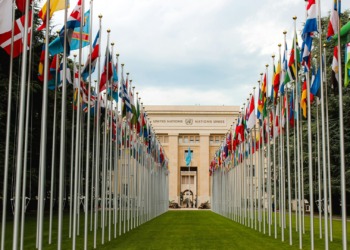Although achieving a historical consensus on reparations for loss and damage suffered by vulnerable countries, COP27 fell short of ensuring the limitation of further harm caused by worsening climate change through increasing mitigation and adaptation actions. Attempts to increase the ambition of national decarbonization plans and to peak global emissions by 2025, as well as to phase out all unabated fossil fuels, have failed — to the benefit of the fossil fuels lobbies.
The COP27 outcome document, “Sharm el-Sheikh Implementation Plan,” does not properly acknowledge the essential role of renewable energy, further weakening the language of the Glasgow Climate Pact.
Both the mitigation and adaptation chapters of the document make no mention of renewable energy, while the use of generic and subjective terms such as “low-emission” and “clean energy” allows for excessive and dangerous reliance on natural gas, nuclear power, and fossil fuel-based power generation coupled with carbon capture and storage.
This is irrational considering that solar and other renewable and clean energy technologies represent immediate solutions to the energy and climate crises, and can offer great help in facing food and water crises as well.
Solar PV in particular is a mature and competitive asset for both mitigation and adaptation. As shown by the Global Solar Council events at COP27, solar panels are able to keep working even during floods and hurricanes, ensure access to power where grids are disrupted or absent, and help drastically reduce emissions.
“Solar PV is a rational decision,” – said José Donoso, the GSC Chairman. “It is the best way forward for people and countries of the world as it makes sense environmentally and economically.”
Developed countries are not fulfilling their commitment regarding funding for developing countries and this may undermine their credibility in regard to multiple aspects of the climate negotiations. Concerning non-party stakeholders, the private sector, businesses and industry are cited in a timid way. More decisive wording is needed to empower the private sector as a strategic pillar in fulfilling the emissions reduction goals.
This confirms the importance of GSC’s presence at COP alongside the Global Renewables Alliance to influence decisions in favor of solar power and other renewables and clean technologies, especially considering COP28 in Dubai, UAE – one of the largest oil producers in the world – will probably feature an even stronger presence of oil and gas lobbies.
“Before mid-century, we already have a critical milestone in 2030, which is approaching fast. Unfortunately, COP27 was a missed opportunity to set forth a firm commitment to seriously accelerate the energy transition,” CEO of GSC Gianni Chianetta added. “Now, we need to start working towards COP28 and engage countries in pledging to phase out of all fossil fuels.”
GSC at COP27: Solar PV is needed at every scale
The GSC activities, initiatives and partnerships at COP27 have all focused on showcasing the potential of solar power and the immediate opportunities from the integration with storage and other renewables and clean technologies, as well as on highlighting the barriers that still need to be removed.
 Despite being the fastest-growing source of power generation, solar photovoltaics still account for only around 4% of global electricity, up from 1% in 2015.
Despite being the fastest-growing source of power generation, solar photovoltaics still account for only around 4% of global electricity, up from 1% in 2015.
For the first time in 2021, solar and wind surpassed 10% of global electricity generation.
However, as the High-Level Climate Champions 2030 Breakthrough target for Clean Power indicates, solar and wind power have to make up at least 40% of global electricity generation by 2030 to keep the 1.5C objective in sight. Their share would then need to rise to 70% by 2050, according to the International Energy Agency’s net-zero scenario.
Such a pathway would require 630 GW of solar PV to be added annually by 2030, which is currently equivalent to installing the world’s largest solar farm every day. Together, the solar and wind capacity added in 2030 would be more than triple the amount installed in 2020.
Total solar PV capacity must grow to around 5 TW in 2030, more than 10 TW in 2040 and more than 14 TW in 2050, according to IRENA and IEA.
For the massive deployment that is required onwards, it is clear we need solar to lead a diversified clean energy mix with wind, energy storage, green hydrogen, and other renewables and clean technologies. Solar power is the leading asset on the global pathway to full decarbonization and needs to be developed at all scales hand in hand with storage.
During COP27, GSC showcased the role of distributed solar PV for people empowerment, broader energy access, and more efficient land use. Rooftop and off-grid solar PV systems can increase energy resiliency and access while lowering power costs, unlocking a broad range of socio-economic benefits for people around the globe while empowering them to contribute to the clean energy transition.
Faster distributed solar PV deployment can also help diversify supply chains and create millions of new jobs.
GSC’s benchmarking analysis of policies, permitting and regulations highlighted how rooftop solar can contribute a significant portion of the total capacity. Confronting the installed capacity and estimated potential capacity of a group of countries, gaps emerged signaling vast untapped potential.
In the overall authorization process, the connection to the grid was identified as more complex than the permitting of the installation. A major challenge remains the high level of inhomogeneity of local authorization procedures in several countries, slowing down the energy transition.
To be on track for net-zero by 2050, IEA estimates that 100 million households need to be equipped with rooftop solar PV globally by 2030, and 240 million by 2050 — up from the current 25 million.
GSC believes more can be achieved with enhanced policy and regulatory support. Soem of the main recommendations identified include:
- Guaranteeing connection and preferred access to the grid for small-scale PV systems;
- simplifying permitting defining maximum mandate times; homologating procedures at the national level;
- increasing transparency and clarity of procedures for investors’ comfort;
- setting specific national targets for rooftop PV;
- adopting and diffusing net metering;
- learning from others and replicating good practices.
GSC will produce a final report that will include policy benchmarking on regulations and authorization procedures to match bottlenecks in emerging markets with good practices and propose recommendations to maximize the uptake of rooftop solar PV.
In order to reach 100% renewable energy and achieve international energy security, large-scale solar PV is critical and must be deployed faster and in a firm connection with energy storage’s diversified solutions.
To accelerate deployment and overcome the global energy crisis in line with the climate goals, there is a need for urgent actions to diversify the supply chain, streamline permitting, and provide clear investment signals. Permitting of large-scale solar projects has to be accelerated, through open call procedures for project applications and a series of fast-track measures the GSC has highlighted. This can quickly bring solar projects in the development pipeline to construction within the next few years.
GSC has also remarked on the importance of unlocking the huge potential of giga-projects by integrating large-scale solar PV with other renewables and storage, activating and scaling key synergies among countries and technologies.
Related Articles: COP27: Anticlimactic Conclusion for the Climate | COP26: Success or Failure? | Climate Funding For Global South Has New Champion: The British People
At an industrial level, it is recommended to improve the modeling of the construction of large plants with multiple subcontractors, taking into account contractual and supply challenges. GSC issued a call to action to speed up timescales for giga-projects and interconnections. It is important to quickly identify suitable areas near consumption areas to optimize the integration of renewable energy sources, as well as to include the modernization of the power grids in the planning.
Giga-projects must be the result of transparent negotiations between the various governments involved and the corporate world.
The example of the interconnection project between Egypt and Greece – in the feasibility study phase – demonstrates how, faced with a concrete project and the possibility of a large investment, the energy authorities can review the regulatory processes in a very short time.
Accelerated timelines for giga-projects can rapidly bring huge benefits to several countries simultaneously, become conduits for renewed international cooperation and convey sustainable development.
The Mediterranean could become a frontrunner in a global initiative, as several giga-projects opportunities can be identified in different regions of the world. Among the giga-projects that can be activated globally, an initiative is under study aiming to transform post-war Ukraine into a renewables stronghold for the entire Europe, producing green hydrogen and distributing it along the Danube.
Solar PV can be Nature’s friend
GSC, WWF, Greenpeace International, and others, showed together at COP27 that a shared vision and complementarity is possible between solar power and Nature.
 As capacity can be deployed to avoid unnecessary land disruption and the exploitation of urban and suitable areas, and to increase recycling targets, solar PV actually brings opportunities for greater biodiversity, helping restore some of the vast amounts already lost.
As capacity can be deployed to avoid unnecessary land disruption and the exploitation of urban and suitable areas, and to increase recycling targets, solar PV actually brings opportunities for greater biodiversity, helping restore some of the vast amounts already lost.
GSC hopes that as this becomes increasingly understood – the new partnerships with environmental groups and beyond the power sector are going in this direction – it will stimulate simplification of the authorization processes, the definition of suitable areas and improved mandates for buildings.
It will also help motivate communities and make more people passionate about solar in line with climate targets, empowering them to push for change. Cooperation at the local level, engaging people on the ground, is the real way to call all stakeholders at different levels (municipalities, regions, and central governments) to faster action and achieve greater social acceptance.
Quality of installations to sustain trust
As more and more people move to solar regardless of their government’s actions, GSC also covered the importance of establishing good standards worldwide already today for the procurement of solar components, to avoid ending up with large quantities of unsustainable debris.
This is relevant both for large-scale and decentralized/off-grid solar PV, and is especially important for developing countries, where people tend to buy cheap products and where proper training programs are expensive.
At its last event at COP27, on Solutions day, GSC invited members of the GSC Technical Committee and international experts to talk about solutions for high-quality solar deployment and disseminate good practices to avoid problems that are already well-known and easily avoidable.
Empowering the youth with solar PV
One of the key highlights of the GSC campaign at COP27 was the strong bond formed with youth groups, young entrepreneurs and activists.
Licypriya Kangujam from India, as well as activists from the Ukrainian NGO Ecoclub and the COP27 youth task force, have visited the Wind and Solar Pavilion to share their experiences and how solar PV is empowering them and their communities.
 From keeping power and heat on in war-zone hospitals to providing electricity for innovative and 100% clean projects and initiatives, several examples of how young people around the world from very diverse environments and contexts are already exploiting the potential of solar energy to change lives, leading the way to a more sustainable and inclusive world.
From keeping power and heat on in war-zone hospitals to providing electricity for innovative and 100% clean projects and initiatives, several examples of how young people around the world from very diverse environments and contexts are already exploiting the potential of solar energy to change lives, leading the way to a more sustainable and inclusive world.
GSC is committed to helping them spread the opportunities from solar at the local level even more.
A campaign for individual action
At COP27, APVIA launched the Pledging Platform in cooperation with GSC. The platform will record the commitments of individuals, as well as of solar companies, developers, funders, and communities, to undertake action.
The main objective of the initiative is to encourage people in supporting the collective race toward a net-zero future and 240 million solar rooftops by 2050, promoting the uptake of distributed solar PV from the residential to the industrial level. GSC is committed to helping disseminate and extend the campaign from Asia to the global level.
Editor’s Note: The opinions expressed here by the authors are their own, not those of Impakter.com — In the Featured Photo: Solar discussion at COP27 in Sharm El-Sheikh, Egypt, November 16, 2022. Featured Photo Credit: UN Climate Change.











